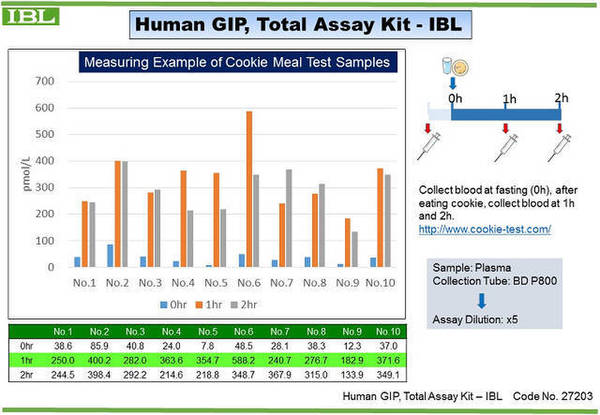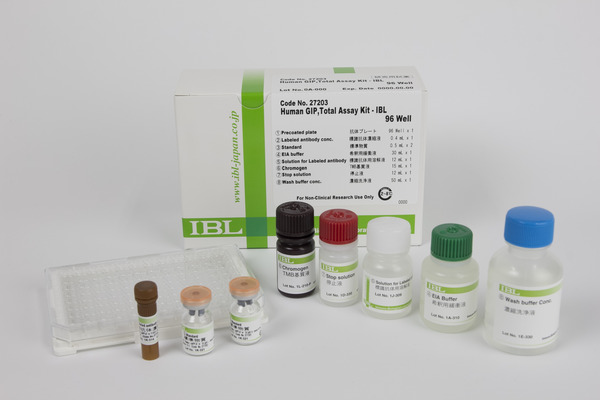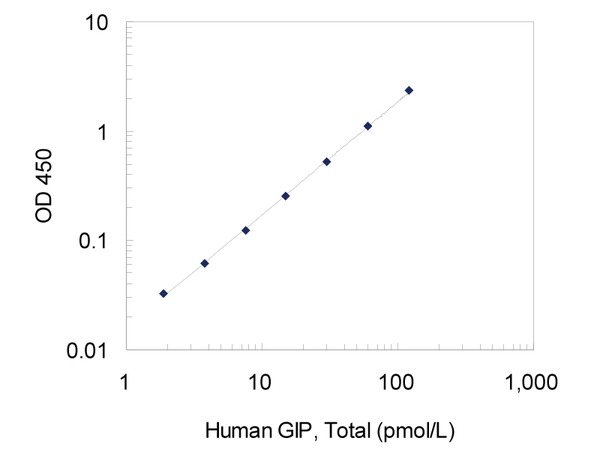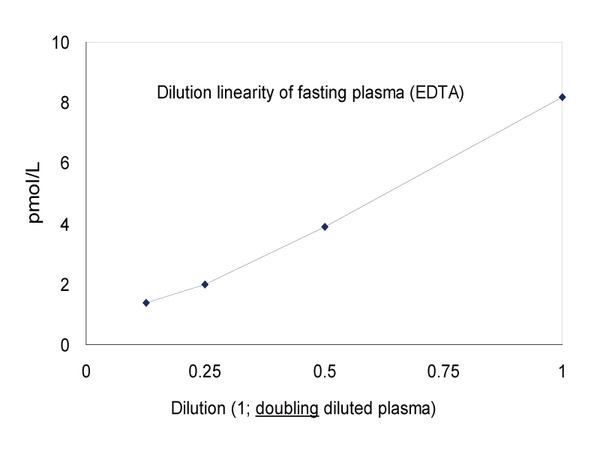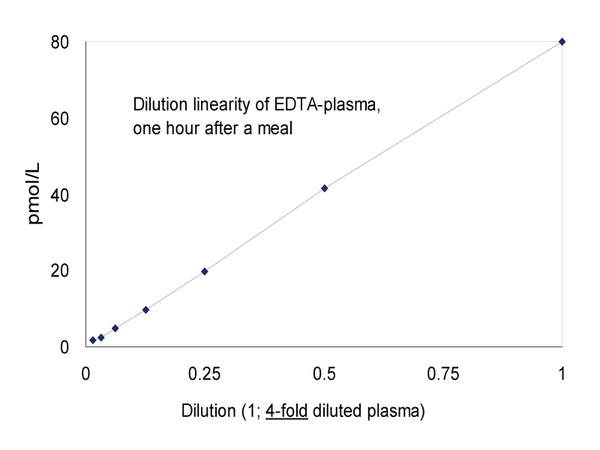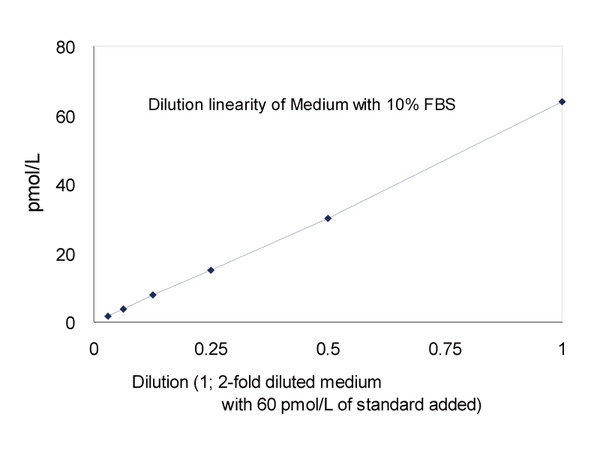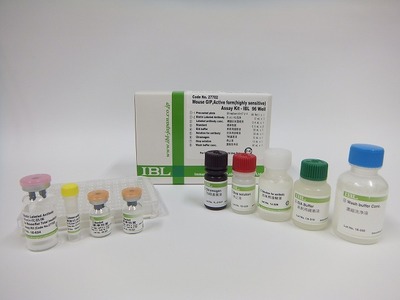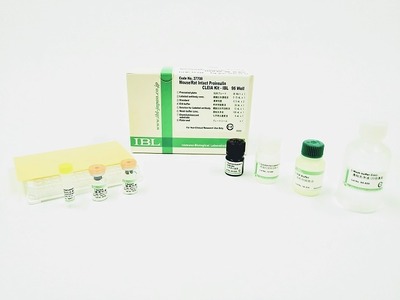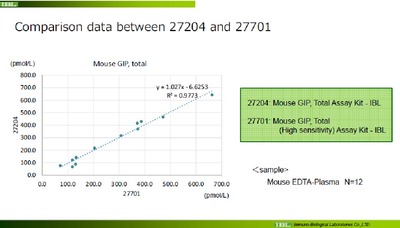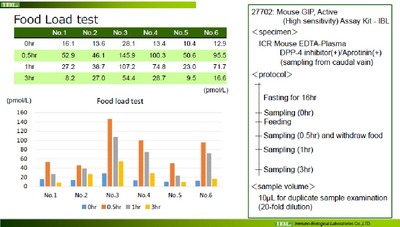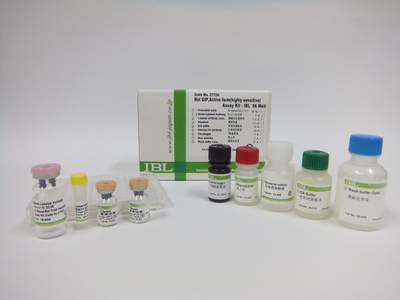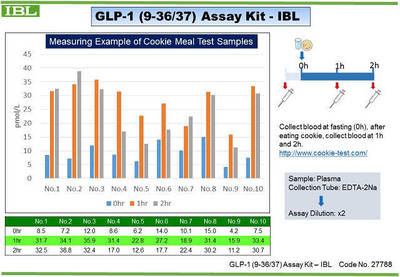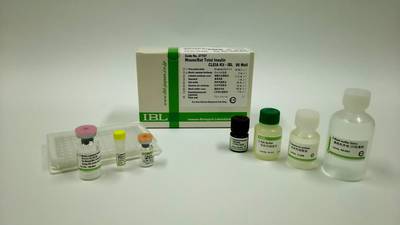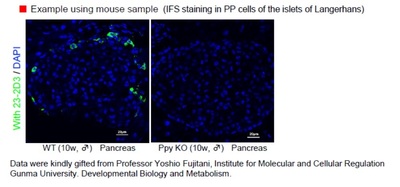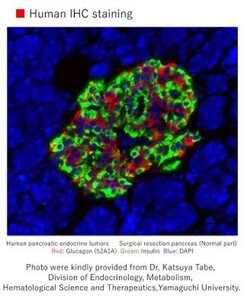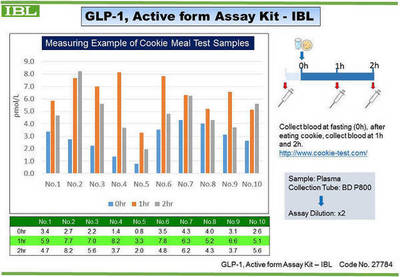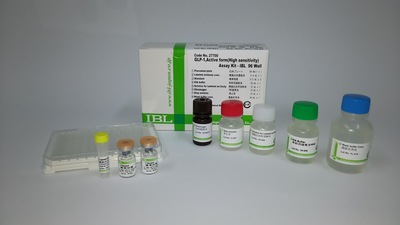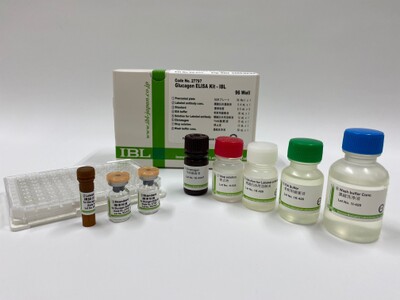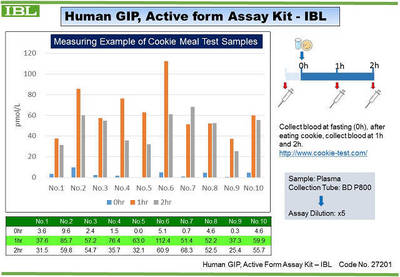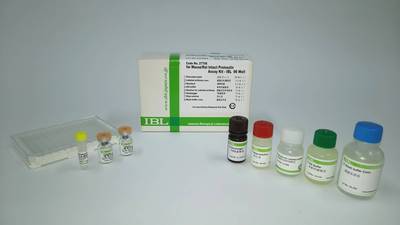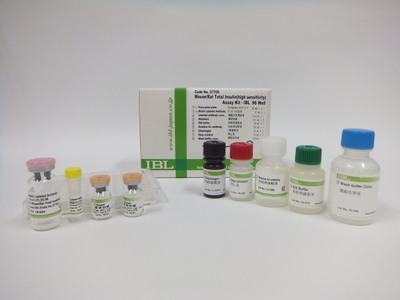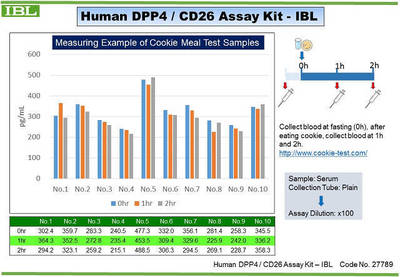- HOME >
- For Researchers >
- Product Search >
- Search Result >
- #27203 Human GIP, Total Assay Kit - IBL
Product Search
#27203 Human GIP, Total Assay Kit - IBL
- Intended Use:
- Research reagents
- Measuring Method:
- ELISA
- Sample Types:
- Human
- Measuring Samples:
- EDTA-plasma, Cell culture supernatant
- Measurement Range:
- 1.88 - 120 pmol/L
- Package Size1:
- 96 Well
※ The product indicated as "Research reagents" in the column Intended Use cannot be used
for diagnostic nor any medical purpose.
※ The datasheet listed on this page is sample only. Please refer to the datasheet
enclosed in the product purchased before use.
Product Overview
Product Overview
| Product Code | 27203 |
|---|---|
| Product Name | Human GIP, Total Assay Kit - IBL |
| Intended Use | Research reagents |
| Measuring Method | ELISA |
| Conjugate | HRP |
| Species | Human |
| Measuring Samples | EDTA-plasma, Cell culture supernatant |
| Measurement Range | 1.88 - 120 pmol/L |
| Primary Reaction | 60 minutes at 37 ℃ |
| Secondary Reaction | 60 minutes at 2 - 8 ℃ |
| Sensitivity | 0.82 pmol/L |
| Specificity | Substance Cross Reactivity Human GIP (1-42) 100.0% Human GIP (3-42) 100.0% Human GIP (1-30) amide < 0.1 % Human GLP-1 (7-36) amide < 0.1 % Human GLP-1 (9-36) amide < 0.1 % Human GLP-2 < 0.1 % Human Glucagon < 0.1 % Human Oxyntomodulin < 0.1 % |
| Storage Condition | 2 - 8 ℃ |
| Poisonous and Deleterious Substances | Not Applicable |
| Cartagena | Not Applicable |
| Measuring Service | Available |
| Package Size 1 | 96 Well |
Product Description
Product Description
Incretins are a group of gastrointestinal hormones that cause an increase in the amount of insulin released from the beta cells of the islets of Langerhans after eating and they also inhibit glucagon release from the alpha cells of the Islets of Langerhans. GIP, typical incretin like GLP-1, was isolated and sequenced from intestinal mucosa as “gastric inhibitory peptide” in 1970, and then it was renamed as “glucose-dependent insulinotropic peptide”. It has been reported that GIP receptor is expressed in cells such as beta cell of pancreas, adipocyte or osteoblastic cell, and it plays essential roles in reserving of ingested nutrients within the body in each cell, and the control of GIP signal can lead to improvement of metabolic syndrome. GIP is rapidly inactivated to GIP (3-42) from active form of GIP (1-42) by DPP-IV in blood. This ELISA kit detects both types of human GIP, active form (1-42) and inactivated form (3-42), and can measure total GIP in samples.
Keywords:
GIP / GLP-1 / Insulin / Incretin
Keywords:
GIP / GLP-1 / Insulin / Incretin
References
References
- Pseudo-hyperglucagonemia Was Observed in the Pancreatectomized Cases When Measured by Glucagon Sandwich ELISA. Kobayashi M et al. J Diabetes Investig. 2020;10.1111/jdi.13325.PMID: 32548980
- Addition of sitagliptin or metformin to insulin monotherapy improves blood glucose control via different effects on insulin and glucagon secretion in hyperglycemic Japanese patients with type 2 diabetes. Otsuka Y et al. Endocr J. 2015;62(2):133-43.PMID: 25328079
- Effects of Miglitol, Acarbose, and Sitagliptin on Plasma Insulin and Gut Peptides in Type 2 Diabetes Mellitus: A Crossover Study. Ueno H et al. Diabetes Ther. 2015 Jun;6(2):187-96.PMID: 26055217
- Effect of supplementary calcium phosphate on plasma gastrointestinal hormones in a double-blind, placebo-controlled, cross-over human study. Trautvetter U et al. Br J Nutr. 2014 Jan 28;111(2):287-93.PMID: 23871132
- Native incretins prevent the development of atherosclerotic lesions in apolipoprotein E knockout mice. Nagashima M et al. Diabetologia. 2011 Oct;54(10):2649-59.PMID: 21786155
- Octreotide-treated diabetes accompanied by endogenous hyperinsulinemic hypoglycemia and protein-losing gastroenteropathy. Takahashi N et al. Case Rep Med. 2011;2011:381203.PMID: 21826148
Note: Retrieve by PMID number in displayed by abstract: http://www.ncbi.nlm.nih.gov
FAQ
FAQ
-
 Q.Is composition of EIA buffer of each ELISA kit all same? Can it be mixed to use?
Q.Is composition of EIA buffer of each ELISA kit all same? Can it be mixed to use?
ELISA common FAQ -
 A.No it isn't. As constitute of each EIA buffer is different, it cannot be mixed with other lots or EIA buffers contained in other kind of ELISA kits.
A.No it isn't. As constitute of each EIA buffer is different, it cannot be mixed with other lots or EIA buffers contained in other kind of ELISA kits. -
 Q.What is the composition of concentrated wash buffer?
Q.What is the composition of concentrated wash buffer?
ELISA common FAQ -
 A.It contains ordinary Tween and phosphate buffer (0.05% Tween-20 in PB).
A.It contains ordinary Tween and phosphate buffer (0.05% Tween-20 in PB). -
 Q.What is the feature of the plate?
Q.What is the feature of the plate?
ELISA common FAQ -
 A.We use plate that is flat bottom and removable strip type plate (8wellx 12 strips).
A.We use plate that is flat bottom and removable strip type plate (8wellx 12 strips). -
 Q.Can I re-use standard after reconstitution?
Q.Can I re-use standard after reconstitution?
ELISA common FAQ -
 A.Not recommended to re-use standard after reconstitution. Please use it at once after the reconstitution.
A.Not recommended to re-use standard after reconstitution. Please use it at once after the reconstitution.
Please note that there are some exceptions. One time freeze-thaw the standard is acceptable for use after reconstitution for some ELISAs.
Please check the details on each product datasheet. -
 Q.What is different between reagent blank and test sample blank?
Q.What is different between reagent blank and test sample blank?
ELISA common FAQ -
 A.Reagent blank means a well is only added EIA buffer and the purpose is confirming whether the Test sample value is influenced by lack of washing process or other operations. Test sample blank means a well is added EIA buffer and HRP antibody and the purpose is to calculate the background.
A.Reagent blank means a well is only added EIA buffer and the purpose is confirming whether the Test sample value is influenced by lack of washing process or other operations. Test sample blank means a well is added EIA buffer and HRP antibody and the purpose is to calculate the background. -
 Q.How many samples can be measured by this kit?
Q.How many samples can be measured by this kit?
ELISA common FAQ -
 A.The pre-coated plate contained in our ELISA kit is 96 wells plate. We recommend to use 16 wells (2 slits) for standard and 80 wells (10 slits) for 40 samples in duplicate.
A.The pre-coated plate contained in our ELISA kit is 96 wells plate. We recommend to use 16 wells (2 slits) for standard and 80 wells (10 slits) for 40 samples in duplicate. -
 Q.What is LOD (Limit of Detection)?
Q.What is LOD (Limit of Detection)?
ELISA common FAQ -
 A.It (LOD) is defined as sensitivity that is calculated using the NCCSL method. Please refer to a datasheet of each product.
A.It (LOD) is defined as sensitivity that is calculated using the NCCSL method. Please refer to a datasheet of each product. -
 Q.What is LOQ (Limit of Quantification)?
Q.What is LOQ (Limit of Quantification)?
ELISA common FAQ -
 A.It (LOQ) is the lowest value of measurement (standard) range. Please refer to a datasheet of each product.
A.It (LOQ) is the lowest value of measurement (standard) range. Please refer to a datasheet of each product. -
 Q.What is the definition of Over Night (O/N) reaction?
Q.What is the definition of Over Night (O/N) reaction?
ELISA common FAQ -
 A.It means that the reaction is required more than 16 hours unless otherwise specifically defined it on a datasheet of each ELISA product.
A.It means that the reaction is required more than 16 hours unless otherwise specifically defined it on a datasheet of each ELISA product. -
 Q.What is the specification of quality control for ELISA product release?
Q.What is the specification of quality control for ELISA product release?
ELISA common FAQ -
 A.The information of specification is available on individual lot specific CoA. Please contact us with your reference lot number for obtaining of specific CoA.
A.The information of specification is available on individual lot specific CoA. Please contact us with your reference lot number for obtaining of specific CoA. -
 Q.What is the number (e.g. 432143214321) at the edge of strips of the plate?
Q.What is the number (e.g. 432143214321) at the edge of strips of the plate?
ELISA common FAQ -
 A.According to the plate maker (ThermoFisher), it does not have any specific meaning as it is just the number of molds.
A.According to the plate maker (ThermoFisher), it does not have any specific meaning as it is just the number of molds. -
 Q.How to wash an ELISA plate?
Q.How to wash an ELISA plate?
ELISA common FAQ -
 A.Washing it by an auto-washer is highly recommended.
A.Washing it by an auto-washer is highly recommended.
If it is not available, please refer to the demo video (only 2 mins) using a washing bottle. -
 Q.The wells turned black during the test with the kit.
Q.The wells turned black during the test with the kit.
ELISA common FAQ -
 A.It is possible that the wells were not washed sufficiently during the washing process after the HRP-labeled antibody reaction.
A.It is possible that the wells were not washed sufficiently during the washing process after the HRP-labeled antibody reaction.
Be sure to wash the wells enough times as described in the data sheet with washing buffer of more than 350 µL.

